Project Management for TFL's Acton Housing Development Project
VerifiedAdded on 2023/06/12
|11
|1996
|249
Report
AI Summary
This report provides a comprehensive analysis of project management strategies employed by Transport for London (TFL) for its housing project in Acton, focusing on the development of approximately 800 homes. It delves into various project management methodologies such as Waterfall and SCRUM, highlighting their applicability to the project's objectives. The report includes a network diagram illustrating project activities, a stakeholder analysis identifying key stakeholders and their interests, and a work breakdown structure (WBS) to delineate project tasks. Furthermore, it assesses potential risks associated with the project, proposing mitigation strategies, and outlines projected standards of quality control across different project aspects. The report concludes by emphasizing the importance of effective project management in large-scale public service projects.
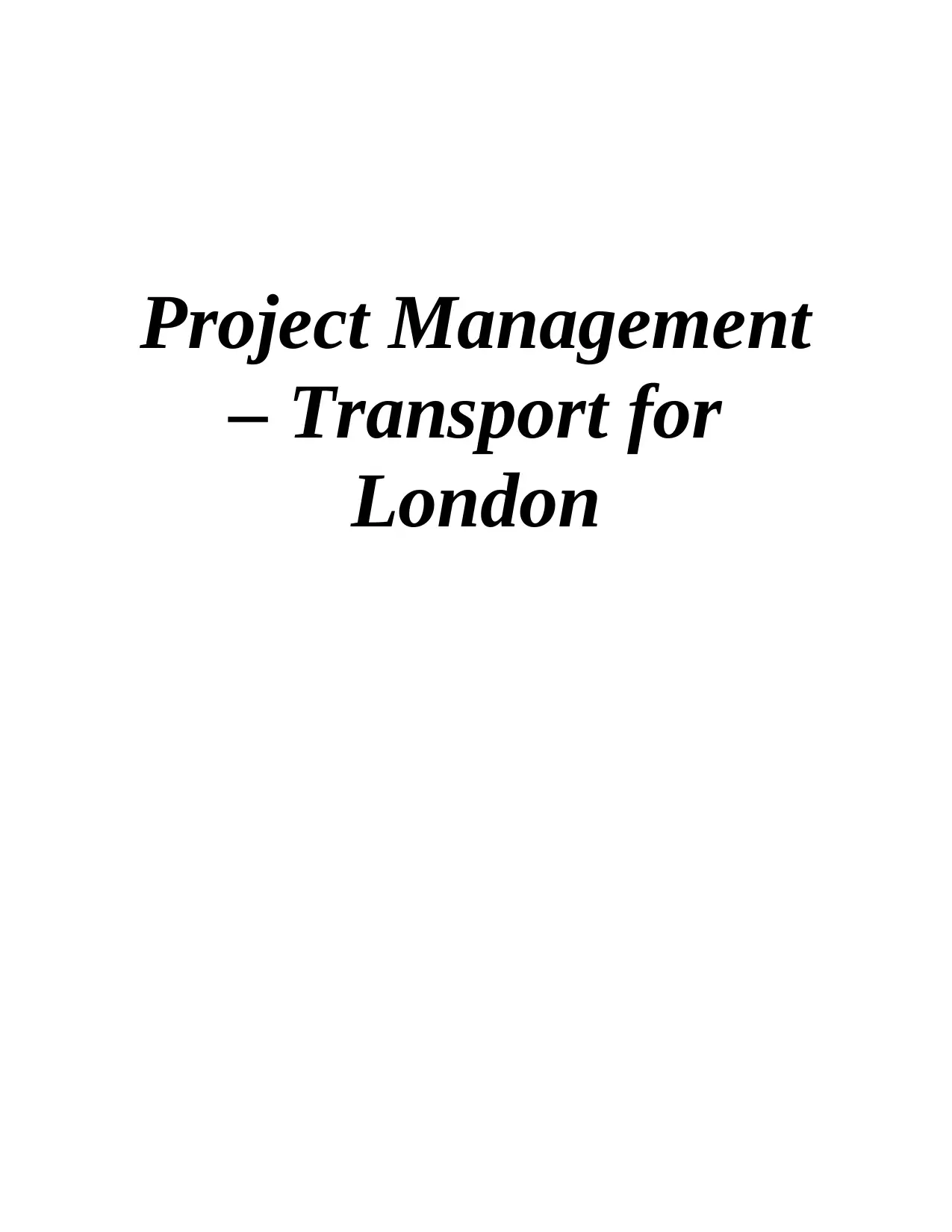
Project Management
– Transport for
London
– Transport for
London
Paraphrase This Document
Need a fresh take? Get an instant paraphrase of this document with our AI Paraphraser
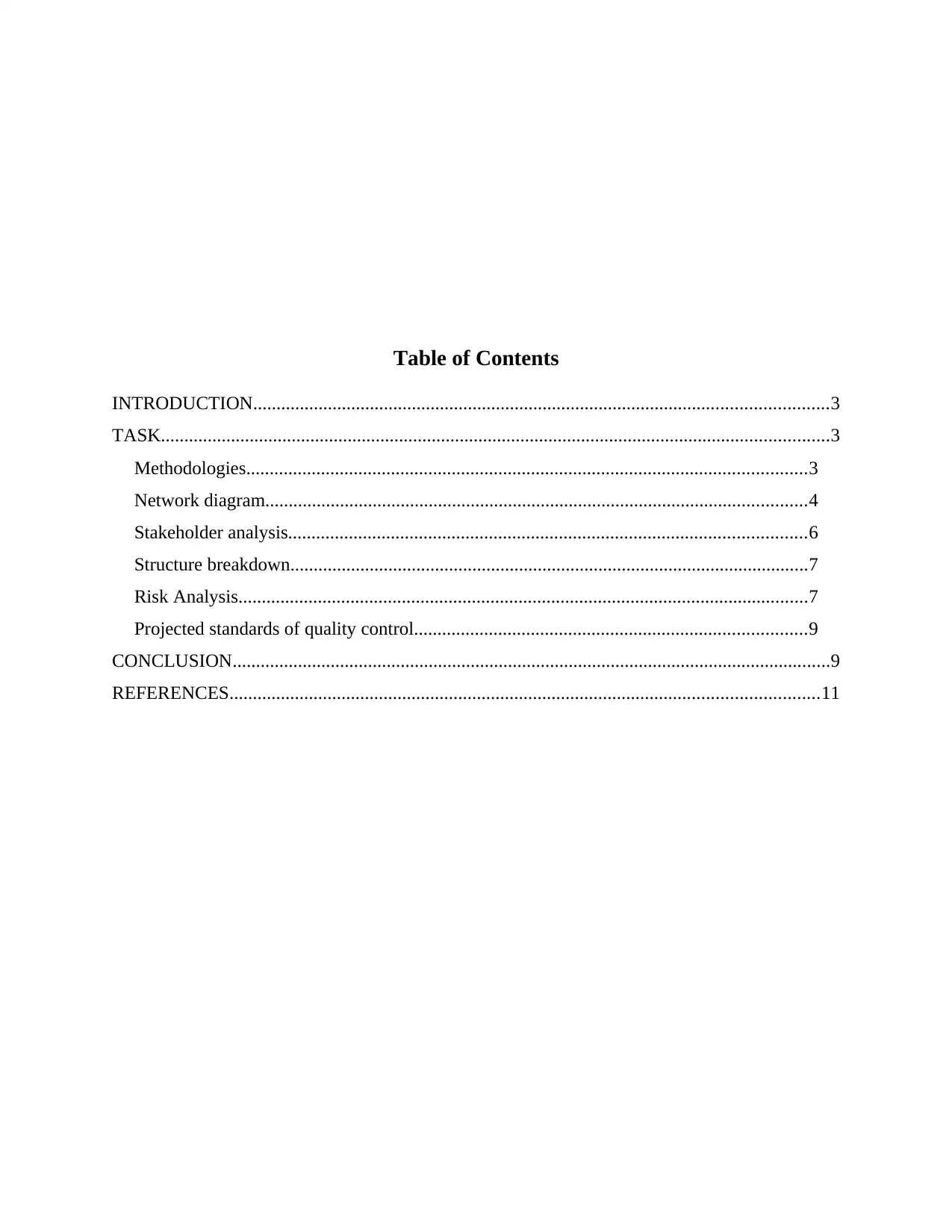
Table of Contents
INTRODUCTION...........................................................................................................................3
TASK...............................................................................................................................................3
Methodologies........................................................................................................................3
Network diagram....................................................................................................................4
Stakeholder analysis...............................................................................................................6
Structure breakdown...............................................................................................................7
Risk Analysis..........................................................................................................................7
Projected standards of quality control....................................................................................9
CONCLUSION................................................................................................................................9
REFERENCES..............................................................................................................................11
INTRODUCTION...........................................................................................................................3
TASK...............................................................................................................................................3
Methodologies........................................................................................................................3
Network diagram....................................................................................................................4
Stakeholder analysis...............................................................................................................6
Structure breakdown...............................................................................................................7
Risk Analysis..........................................................................................................................7
Projected standards of quality control....................................................................................9
CONCLUSION................................................................................................................................9
REFERENCES..............................................................................................................................11
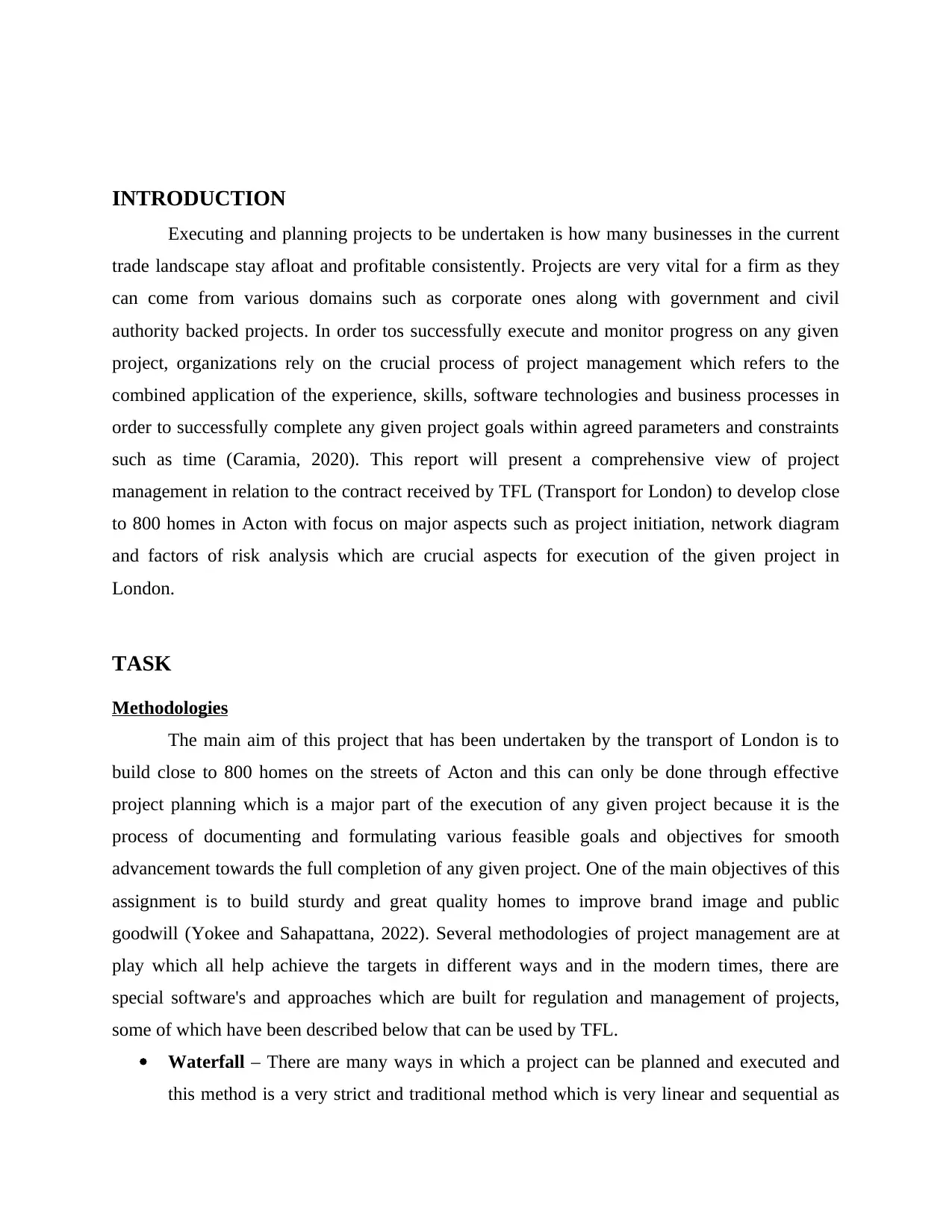
INTRODUCTION
Executing and planning projects to be undertaken is how many businesses in the current
trade landscape stay afloat and profitable consistently. Projects are very vital for a firm as they
can come from various domains such as corporate ones along with government and civil
authority backed projects. In order tos successfully execute and monitor progress on any given
project, organizations rely on the crucial process of project management which refers to the
combined application of the experience, skills, software technologies and business processes in
order to successfully complete any given project goals within agreed parameters and constraints
such as time (Caramia, 2020). This report will present a comprehensive view of project
management in relation to the contract received by TFL (Transport for London) to develop close
to 800 homes in Acton with focus on major aspects such as project initiation, network diagram
and factors of risk analysis which are crucial aspects for execution of the given project in
London.
TASK
Methodologies
The main aim of this project that has been undertaken by the transport of London is to
build close to 800 homes on the streets of Acton and this can only be done through effective
project planning which is a major part of the execution of any given project because it is the
process of documenting and formulating various feasible goals and objectives for smooth
advancement towards the full completion of any given project. One of the main objectives of this
assignment is to build sturdy and great quality homes to improve brand image and public
goodwill (Yokee and Sahapattana, 2022). Several methodologies of project management are at
play which all help achieve the targets in different ways and in the modern times, there are
special software's and approaches which are built for regulation and management of projects,
some of which have been described below that can be used by TFL.
Waterfall – There are many ways in which a project can be planned and executed and
this method is a very strict and traditional method which is very linear and sequential as
Executing and planning projects to be undertaken is how many businesses in the current
trade landscape stay afloat and profitable consistently. Projects are very vital for a firm as they
can come from various domains such as corporate ones along with government and civil
authority backed projects. In order tos successfully execute and monitor progress on any given
project, organizations rely on the crucial process of project management which refers to the
combined application of the experience, skills, software technologies and business processes in
order to successfully complete any given project goals within agreed parameters and constraints
such as time (Caramia, 2020). This report will present a comprehensive view of project
management in relation to the contract received by TFL (Transport for London) to develop close
to 800 homes in Acton with focus on major aspects such as project initiation, network diagram
and factors of risk analysis which are crucial aspects for execution of the given project in
London.
TASK
Methodologies
The main aim of this project that has been undertaken by the transport of London is to
build close to 800 homes on the streets of Acton and this can only be done through effective
project planning which is a major part of the execution of any given project because it is the
process of documenting and formulating various feasible goals and objectives for smooth
advancement towards the full completion of any given project. One of the main objectives of this
assignment is to build sturdy and great quality homes to improve brand image and public
goodwill (Yokee and Sahapattana, 2022). Several methodologies of project management are at
play which all help achieve the targets in different ways and in the modern times, there are
special software's and approaches which are built for regulation and management of projects,
some of which have been described below that can be used by TFL.
Waterfall – There are many ways in which a project can be planned and executed and
this method is a very strict and traditional method which is very linear and sequential as
⊘ This is a preview!⊘
Do you want full access?
Subscribe today to unlock all pages.

Trusted by 1+ million students worldwide
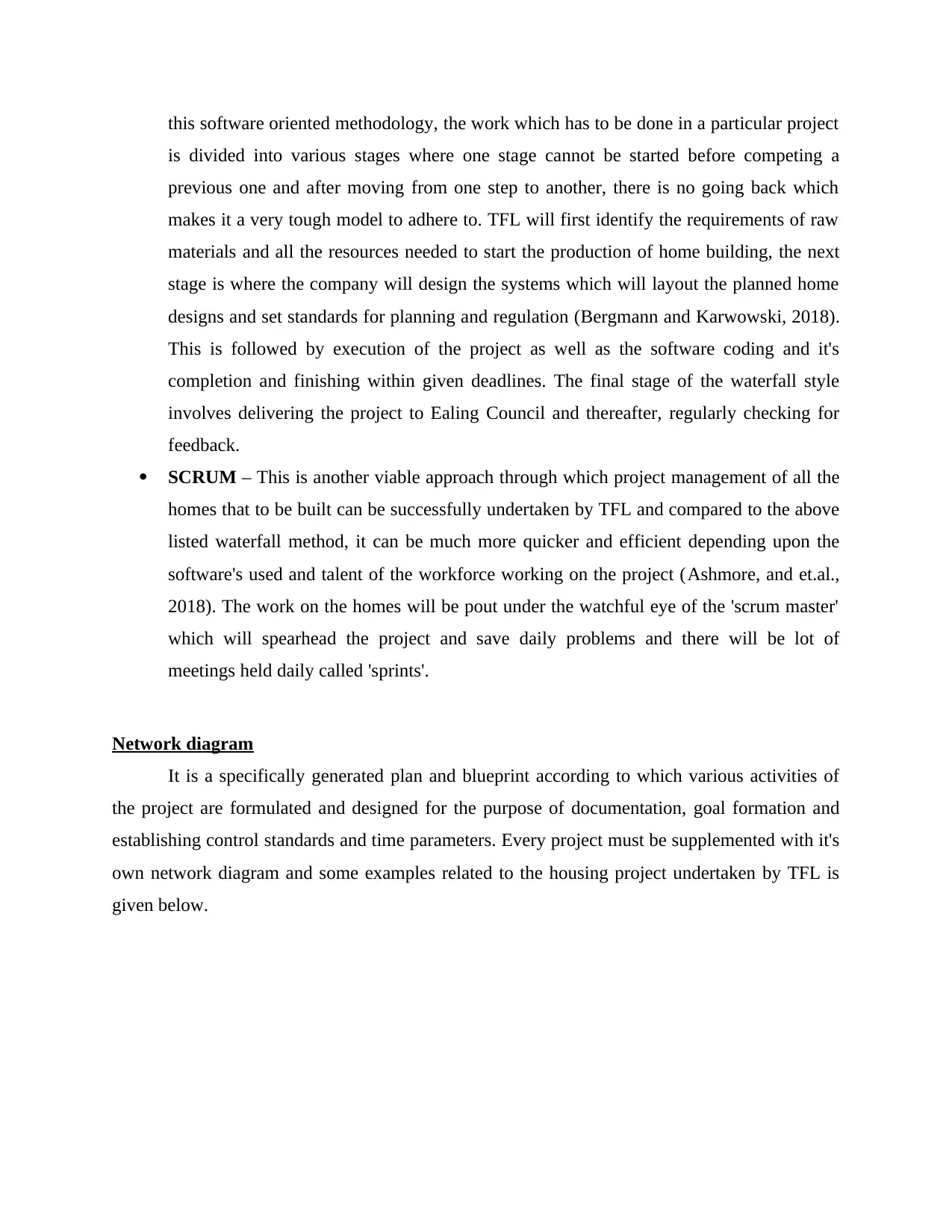
this software oriented methodology, the work which has to be done in a particular project
is divided into various stages where one stage cannot be started before competing a
previous one and after moving from one step to another, there is no going back which
makes it a very tough model to adhere to. TFL will first identify the requirements of raw
materials and all the resources needed to start the production of home building, the next
stage is where the company will design the systems which will layout the planned home
designs and set standards for planning and regulation (Bergmann and Karwowski, 2018).
This is followed by execution of the project as well as the software coding and it's
completion and finishing within given deadlines. The final stage of the waterfall style
involves delivering the project to Ealing Council and thereafter, regularly checking for
feedback.
SCRUM – This is another viable approach through which project management of all the
homes that to be built can be successfully undertaken by TFL and compared to the above
listed waterfall method, it can be much more quicker and efficient depending upon the
software's used and talent of the workforce working on the project (Ashmore, and et.al.,
2018). The work on the homes will be pout under the watchful eye of the 'scrum master'
which will spearhead the project and save daily problems and there will be lot of
meetings held daily called 'sprints'.
Network diagram
It is a specifically generated plan and blueprint according to which various activities of
the project are formulated and designed for the purpose of documentation, goal formation and
establishing control standards and time parameters. Every project must be supplemented with it's
own network diagram and some examples related to the housing project undertaken by TFL is
given below.
is divided into various stages where one stage cannot be started before competing a
previous one and after moving from one step to another, there is no going back which
makes it a very tough model to adhere to. TFL will first identify the requirements of raw
materials and all the resources needed to start the production of home building, the next
stage is where the company will design the systems which will layout the planned home
designs and set standards for planning and regulation (Bergmann and Karwowski, 2018).
This is followed by execution of the project as well as the software coding and it's
completion and finishing within given deadlines. The final stage of the waterfall style
involves delivering the project to Ealing Council and thereafter, regularly checking for
feedback.
SCRUM – This is another viable approach through which project management of all the
homes that to be built can be successfully undertaken by TFL and compared to the above
listed waterfall method, it can be much more quicker and efficient depending upon the
software's used and talent of the workforce working on the project (Ashmore, and et.al.,
2018). The work on the homes will be pout under the watchful eye of the 'scrum master'
which will spearhead the project and save daily problems and there will be lot of
meetings held daily called 'sprints'.
Network diagram
It is a specifically generated plan and blueprint according to which various activities of
the project are formulated and designed for the purpose of documentation, goal formation and
establishing control standards and time parameters. Every project must be supplemented with it's
own network diagram and some examples related to the housing project undertaken by TFL is
given below.
Paraphrase This Document
Need a fresh take? Get an instant paraphrase of this document with our AI Paraphraser
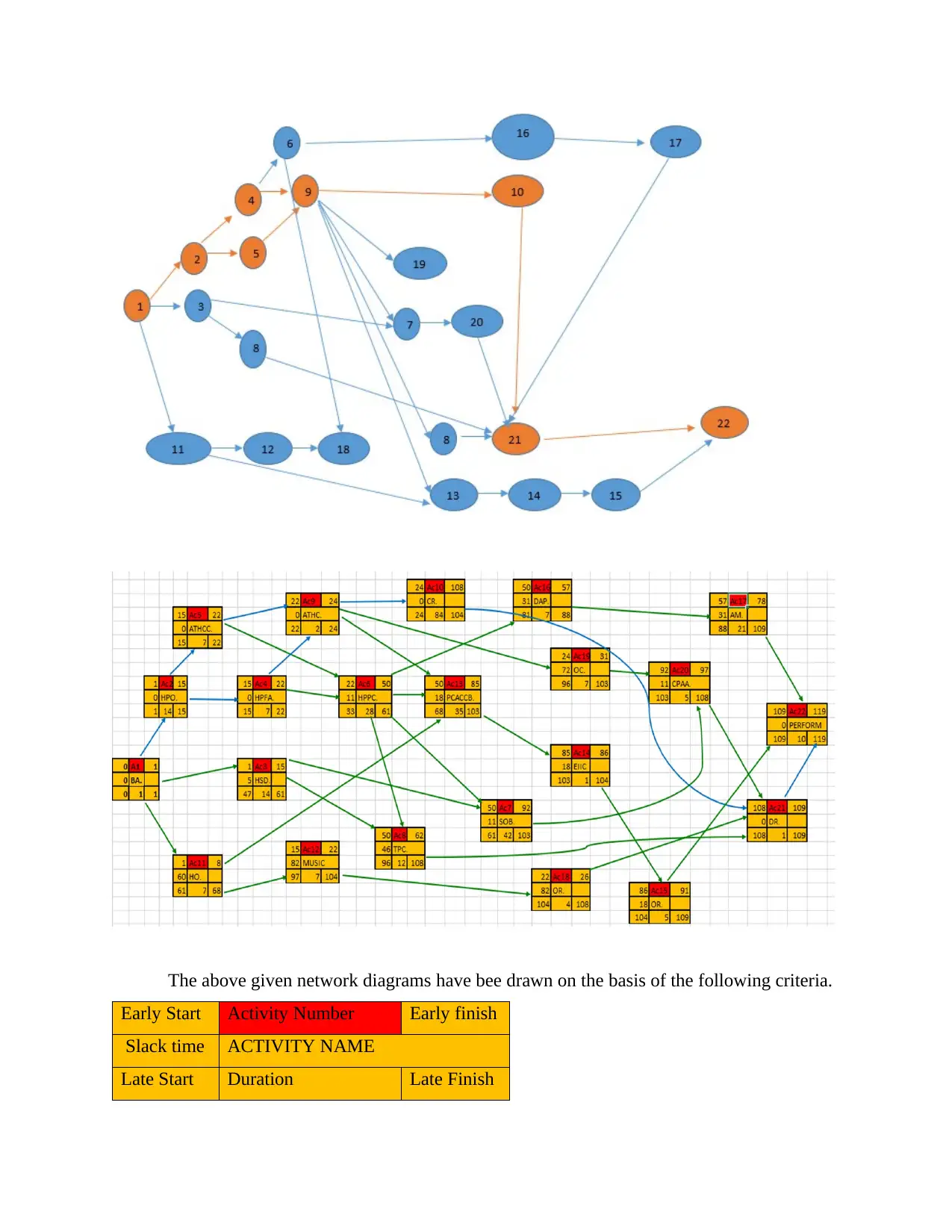
The above given network diagrams have bee drawn on the basis of the following criteria.
Early Start Activity Number Early finish
Slack time ACTIVITY NAME
Late Start Duration Late Finish
Early Start Activity Number Early finish
Slack time ACTIVITY NAME
Late Start Duration Late Finish
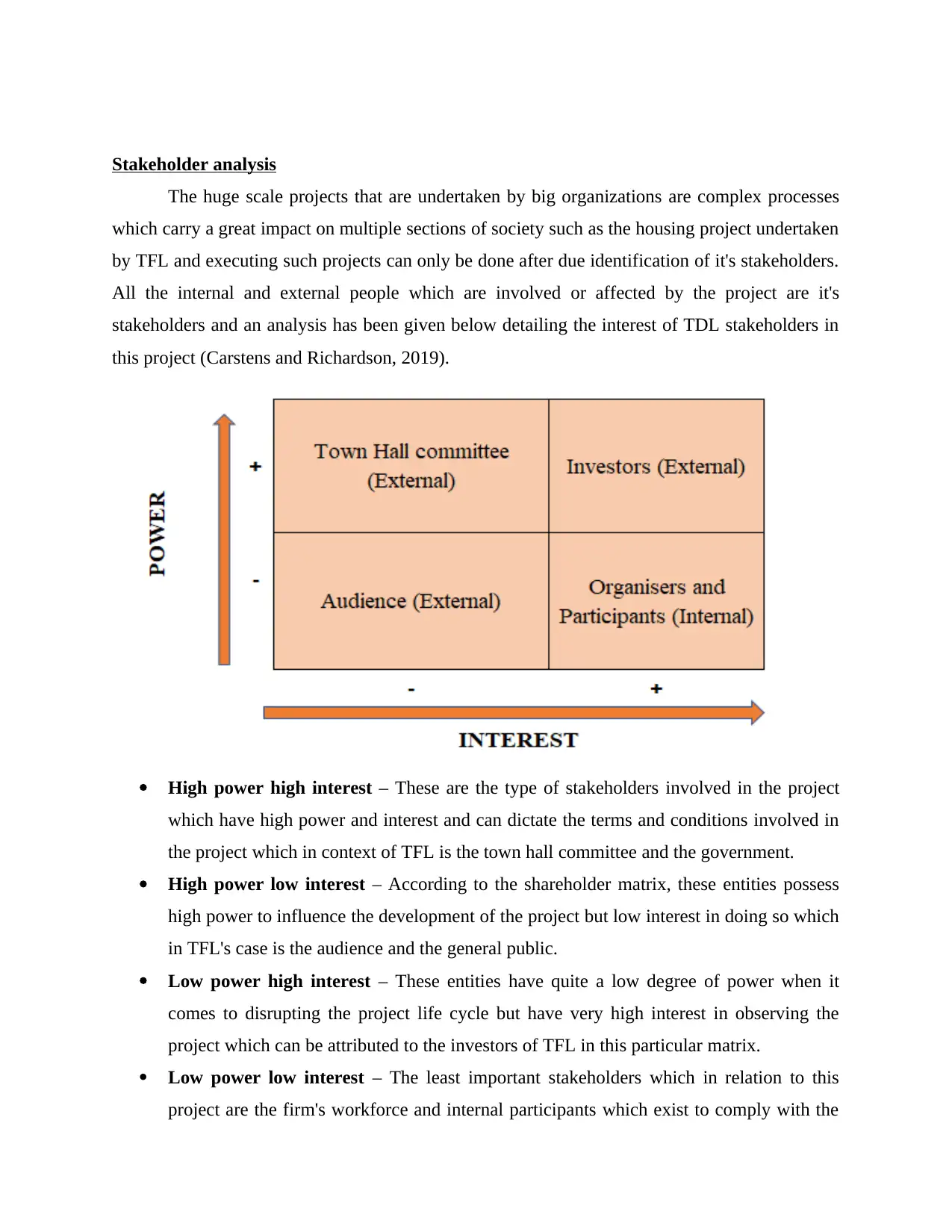
Stakeholder analysis
The huge scale projects that are undertaken by big organizations are complex processes
which carry a great impact on multiple sections of society such as the housing project undertaken
by TFL and executing such projects can only be done after due identification of it's stakeholders.
All the internal and external people which are involved or affected by the project are it's
stakeholders and an analysis has been given below detailing the interest of TDL stakeholders in
this project (Carstens and Richardson, 2019).
High power high interest – These are the type of stakeholders involved in the project
which have high power and interest and can dictate the terms and conditions involved in
the project which in context of TFL is the town hall committee and the government.
High power low interest – According to the shareholder matrix, these entities possess
high power to influence the development of the project but low interest in doing so which
in TFL's case is the audience and the general public.
Low power high interest – These entities have quite a low degree of power when it
comes to disrupting the project life cycle but have very high interest in observing the
project which can be attributed to the investors of TFL in this particular matrix.
Low power low interest – The least important stakeholders which in relation to this
project are the firm's workforce and internal participants which exist to comply with the
The huge scale projects that are undertaken by big organizations are complex processes
which carry a great impact on multiple sections of society such as the housing project undertaken
by TFL and executing such projects can only be done after due identification of it's stakeholders.
All the internal and external people which are involved or affected by the project are it's
stakeholders and an analysis has been given below detailing the interest of TDL stakeholders in
this project (Carstens and Richardson, 2019).
High power high interest – These are the type of stakeholders involved in the project
which have high power and interest and can dictate the terms and conditions involved in
the project which in context of TFL is the town hall committee and the government.
High power low interest – According to the shareholder matrix, these entities possess
high power to influence the development of the project but low interest in doing so which
in TFL's case is the audience and the general public.
Low power high interest – These entities have quite a low degree of power when it
comes to disrupting the project life cycle but have very high interest in observing the
project which can be attributed to the investors of TFL in this particular matrix.
Low power low interest – The least important stakeholders which in relation to this
project are the firm's workforce and internal participants which exist to comply with the
⊘ This is a preview!⊘
Do you want full access?
Subscribe today to unlock all pages.

Trusted by 1+ million students worldwide
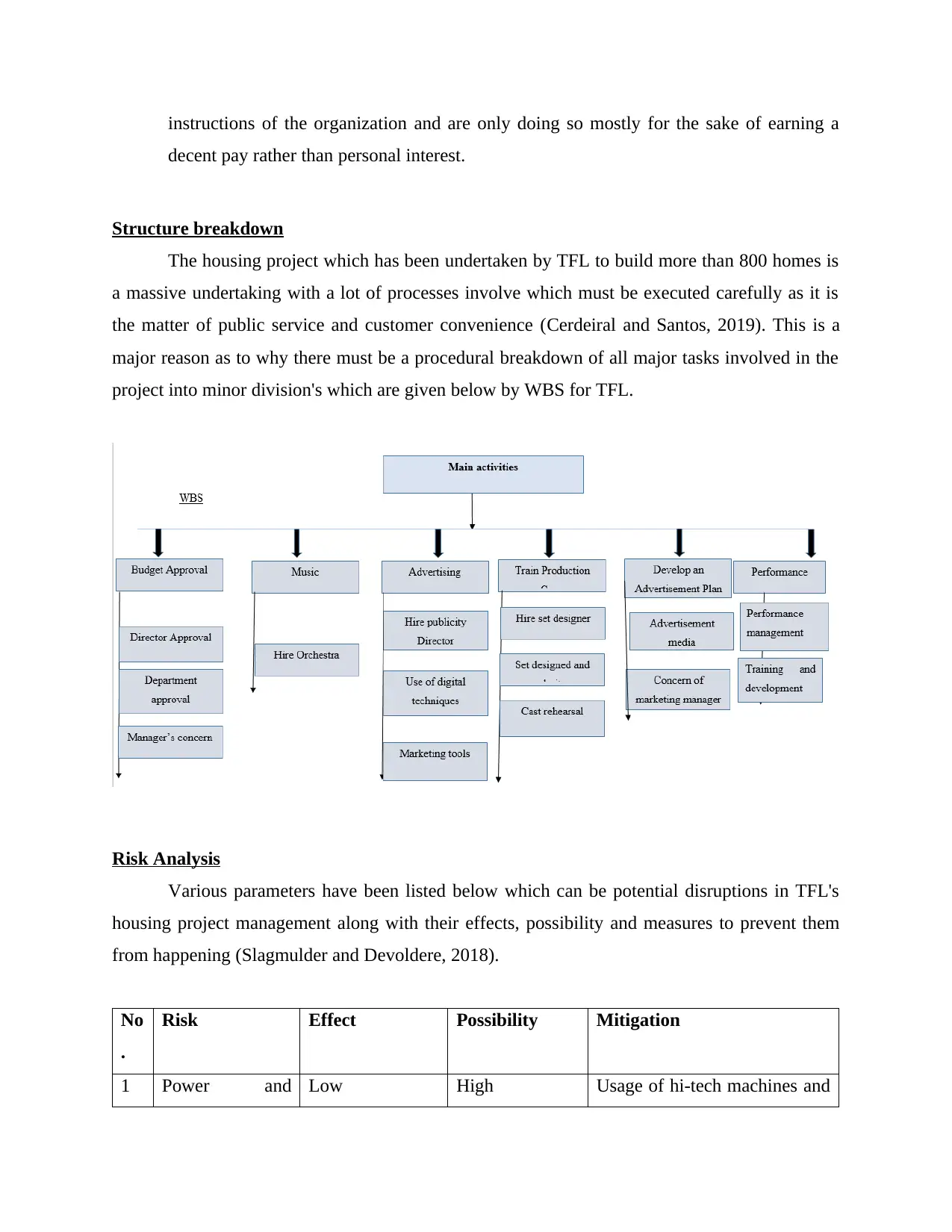
instructions of the organization and are only doing so mostly for the sake of earning a
decent pay rather than personal interest.
Structure breakdown
The housing project which has been undertaken by TFL to build more than 800 homes is
a massive undertaking with a lot of processes involve which must be executed carefully as it is
the matter of public service and customer convenience (Cerdeiral and Santos, 2019). This is a
major reason as to why there must be a procedural breakdown of all major tasks involved in the
project into minor division's which are given below by WBS for TFL.
Risk Analysis
Various parameters have been listed below which can be potential disruptions in TFL's
housing project management along with their effects, possibility and measures to prevent them
from happening (Slagmulder and Devoldere, 2018).
No
.
Risk Effect Possibility Mitigation
1 Power and Low High Usage of hi-tech machines and
decent pay rather than personal interest.
Structure breakdown
The housing project which has been undertaken by TFL to build more than 800 homes is
a massive undertaking with a lot of processes involve which must be executed carefully as it is
the matter of public service and customer convenience (Cerdeiral and Santos, 2019). This is a
major reason as to why there must be a procedural breakdown of all major tasks involved in the
project into minor division's which are given below by WBS for TFL.
Risk Analysis
Various parameters have been listed below which can be potential disruptions in TFL's
housing project management along with their effects, possibility and measures to prevent them
from happening (Slagmulder and Devoldere, 2018).
No
.
Risk Effect Possibility Mitigation
1 Power and Low High Usage of hi-tech machines and
Paraphrase This Document
Need a fresh take? Get an instant paraphrase of this document with our AI Paraphraser
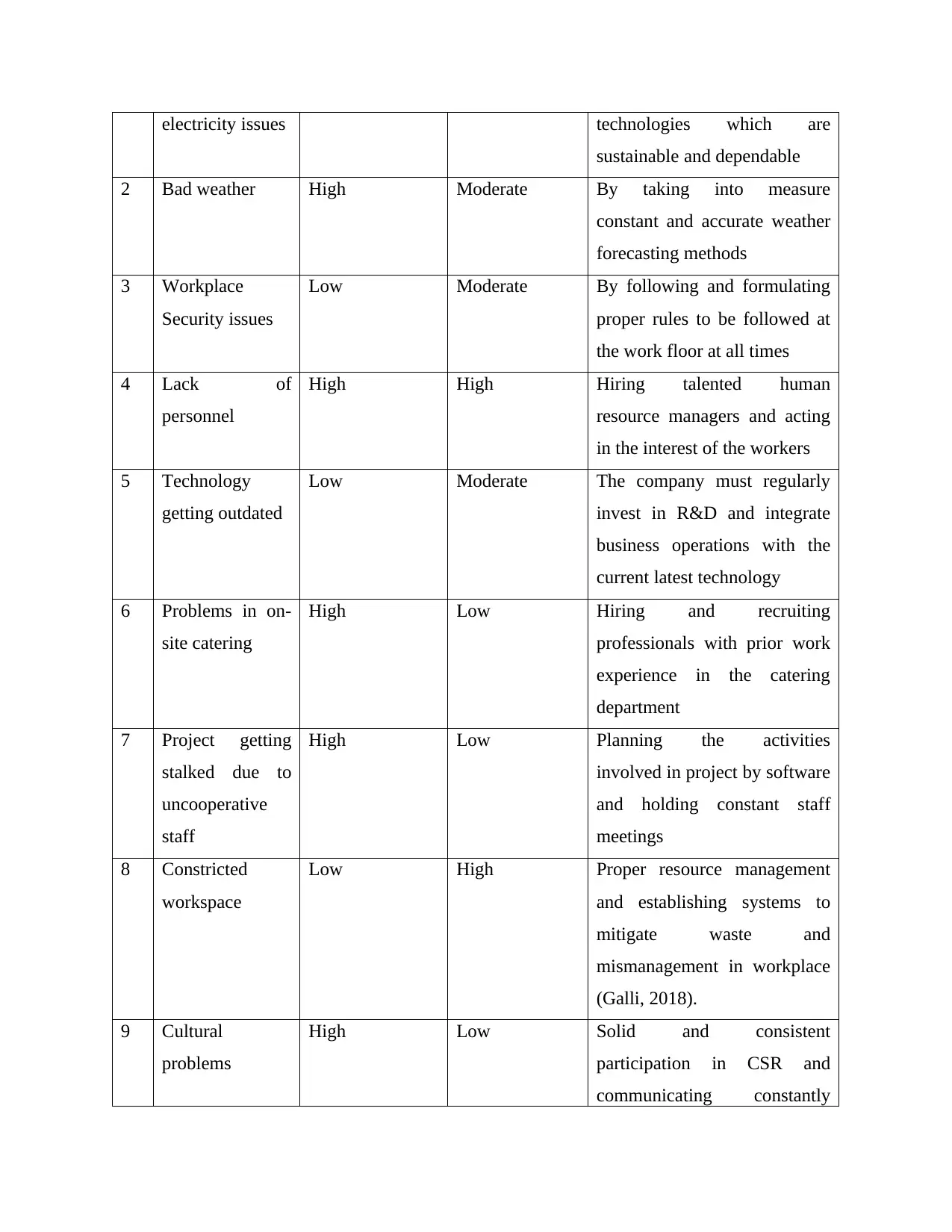
electricity issues technologies which are
sustainable and dependable
2 Bad weather High Moderate By taking into measure
constant and accurate weather
forecasting methods
3 Workplace
Security issues
Low Moderate By following and formulating
proper rules to be followed at
the work floor at all times
4 Lack of
personnel
High High Hiring talented human
resource managers and acting
in the interest of the workers
5 Technology
getting outdated
Low Moderate The company must regularly
invest in R&D and integrate
business operations with the
current latest technology
6 Problems in on-
site catering
High Low Hiring and recruiting
professionals with prior work
experience in the catering
department
7 Project getting
stalked due to
uncooperative
staff
High Low Planning the activities
involved in project by software
and holding constant staff
meetings
8 Constricted
workspace
Low High Proper resource management
and establishing systems to
mitigate waste and
mismanagement in workplace
(Galli, 2018).
9 Cultural
problems
High Low Solid and consistent
participation in CSR and
communicating constantly
sustainable and dependable
2 Bad weather High Moderate By taking into measure
constant and accurate weather
forecasting methods
3 Workplace
Security issues
Low Moderate By following and formulating
proper rules to be followed at
the work floor at all times
4 Lack of
personnel
High High Hiring talented human
resource managers and acting
in the interest of the workers
5 Technology
getting outdated
Low Moderate The company must regularly
invest in R&D and integrate
business operations with the
current latest technology
6 Problems in on-
site catering
High Low Hiring and recruiting
professionals with prior work
experience in the catering
department
7 Project getting
stalked due to
uncooperative
staff
High Low Planning the activities
involved in project by software
and holding constant staff
meetings
8 Constricted
workspace
Low High Proper resource management
and establishing systems to
mitigate waste and
mismanagement in workplace
(Galli, 2018).
9 Cultural
problems
High Low Solid and consistent
participation in CSR and
communicating constantly
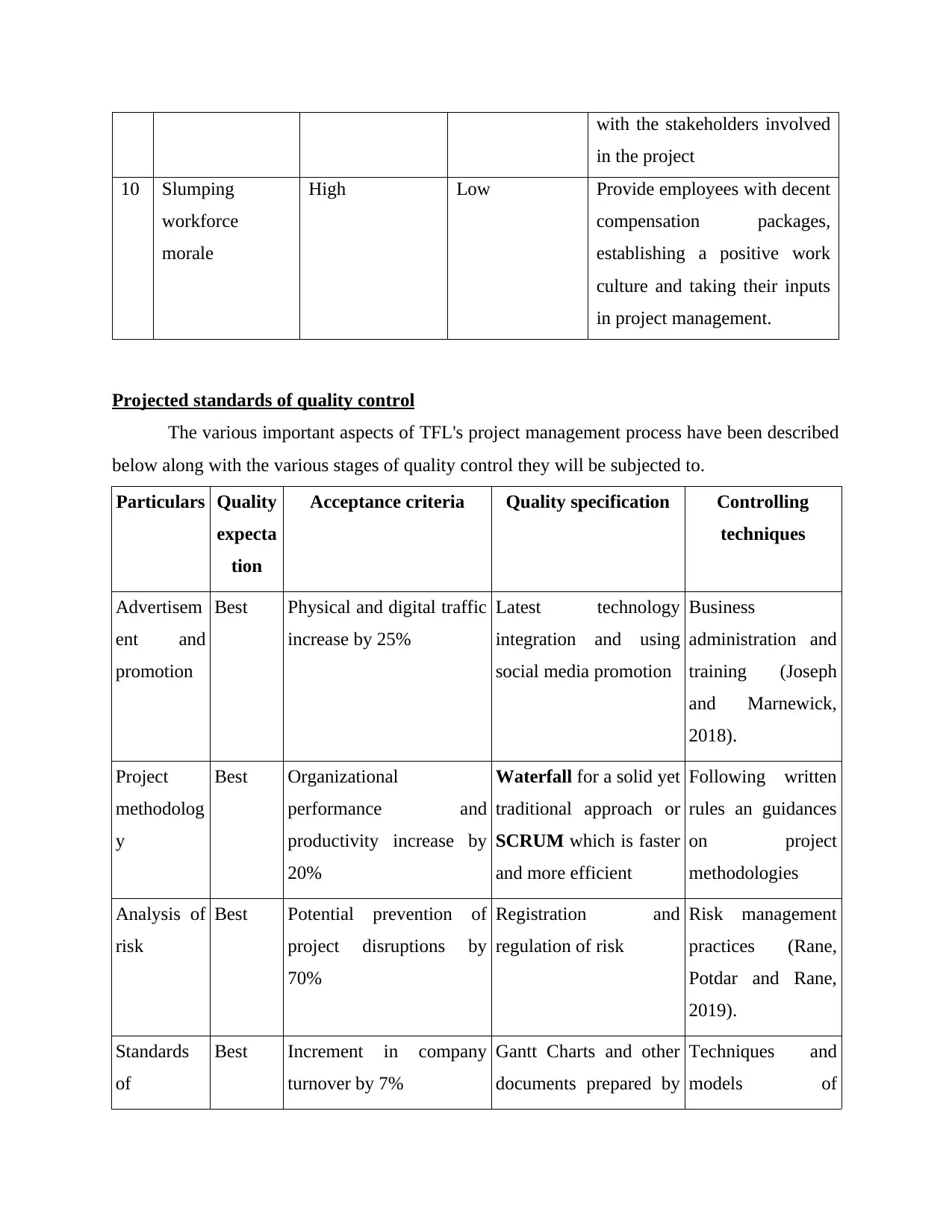
with the stakeholders involved
in the project
10 Slumping
workforce
morale
High Low Provide employees with decent
compensation packages,
establishing a positive work
culture and taking their inputs
in project management.
Projected standards of quality control
The various important aspects of TFL's project management process have been described
below along with the various stages of quality control they will be subjected to.
Particulars Quality
expecta
tion
Acceptance criteria Quality specification Controlling
techniques
Advertisem
ent and
promotion
Best Physical and digital traffic
increase by 25%
Latest technology
integration and using
social media promotion
Business
administration and
training (Joseph
and Marnewick,
2018).
Project
methodolog
y
Best Organizational
performance and
productivity increase by
20%
Waterfall for a solid yet
traditional approach or
SCRUM which is faster
and more efficient
Following written
rules an guidances
on project
methodologies
Analysis of
risk
Best Potential prevention of
project disruptions by
70%
Registration and
regulation of risk
Risk management
practices (Rane,
Potdar and Rane,
2019).
Standards
of
Best Increment in company
turnover by 7%
Gantt Charts and other
documents prepared by
Techniques and
models of
in the project
10 Slumping
workforce
morale
High Low Provide employees with decent
compensation packages,
establishing a positive work
culture and taking their inputs
in project management.
Projected standards of quality control
The various important aspects of TFL's project management process have been described
below along with the various stages of quality control they will be subjected to.
Particulars Quality
expecta
tion
Acceptance criteria Quality specification Controlling
techniques
Advertisem
ent and
promotion
Best Physical and digital traffic
increase by 25%
Latest technology
integration and using
social media promotion
Business
administration and
training (Joseph
and Marnewick,
2018).
Project
methodolog
y
Best Organizational
performance and
productivity increase by
20%
Waterfall for a solid yet
traditional approach or
SCRUM which is faster
and more efficient
Following written
rules an guidances
on project
methodologies
Analysis of
risk
Best Potential prevention of
project disruptions by
70%
Registration and
regulation of risk
Risk management
practices (Rane,
Potdar and Rane,
2019).
Standards
of
Best Increment in company
turnover by 7%
Gantt Charts and other
documents prepared by
Techniques and
models of
⊘ This is a preview!⊘
Do you want full access?
Subscribe today to unlock all pages.

Trusted by 1+ million students worldwide
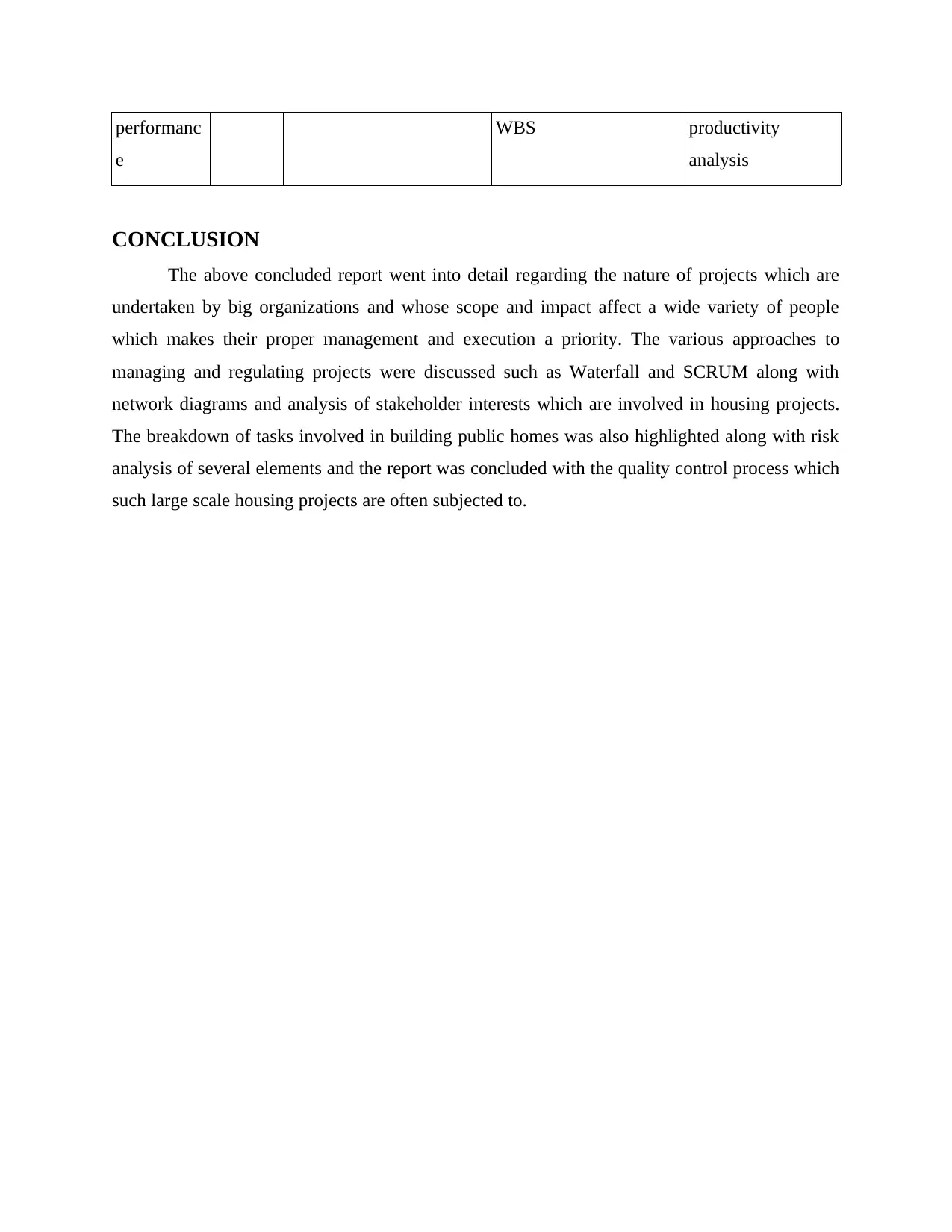
performanc
e
WBS productivity
analysis
CONCLUSION
The above concluded report went into detail regarding the nature of projects which are
undertaken by big organizations and whose scope and impact affect a wide variety of people
which makes their proper management and execution a priority. The various approaches to
managing and regulating projects were discussed such as Waterfall and SCRUM along with
network diagrams and analysis of stakeholder interests which are involved in housing projects.
The breakdown of tasks involved in building public homes was also highlighted along with risk
analysis of several elements and the report was concluded with the quality control process which
such large scale housing projects are often subjected to.
e
WBS productivity
analysis
CONCLUSION
The above concluded report went into detail regarding the nature of projects which are
undertaken by big organizations and whose scope and impact affect a wide variety of people
which makes their proper management and execution a priority. The various approaches to
managing and regulating projects were discussed such as Waterfall and SCRUM along with
network diagrams and analysis of stakeholder interests which are involved in housing projects.
The breakdown of tasks involved in building public homes was also highlighted along with risk
analysis of several elements and the report was concluded with the quality control process which
such large scale housing projects are often subjected to.
Paraphrase This Document
Need a fresh take? Get an instant paraphrase of this document with our AI Paraphraser
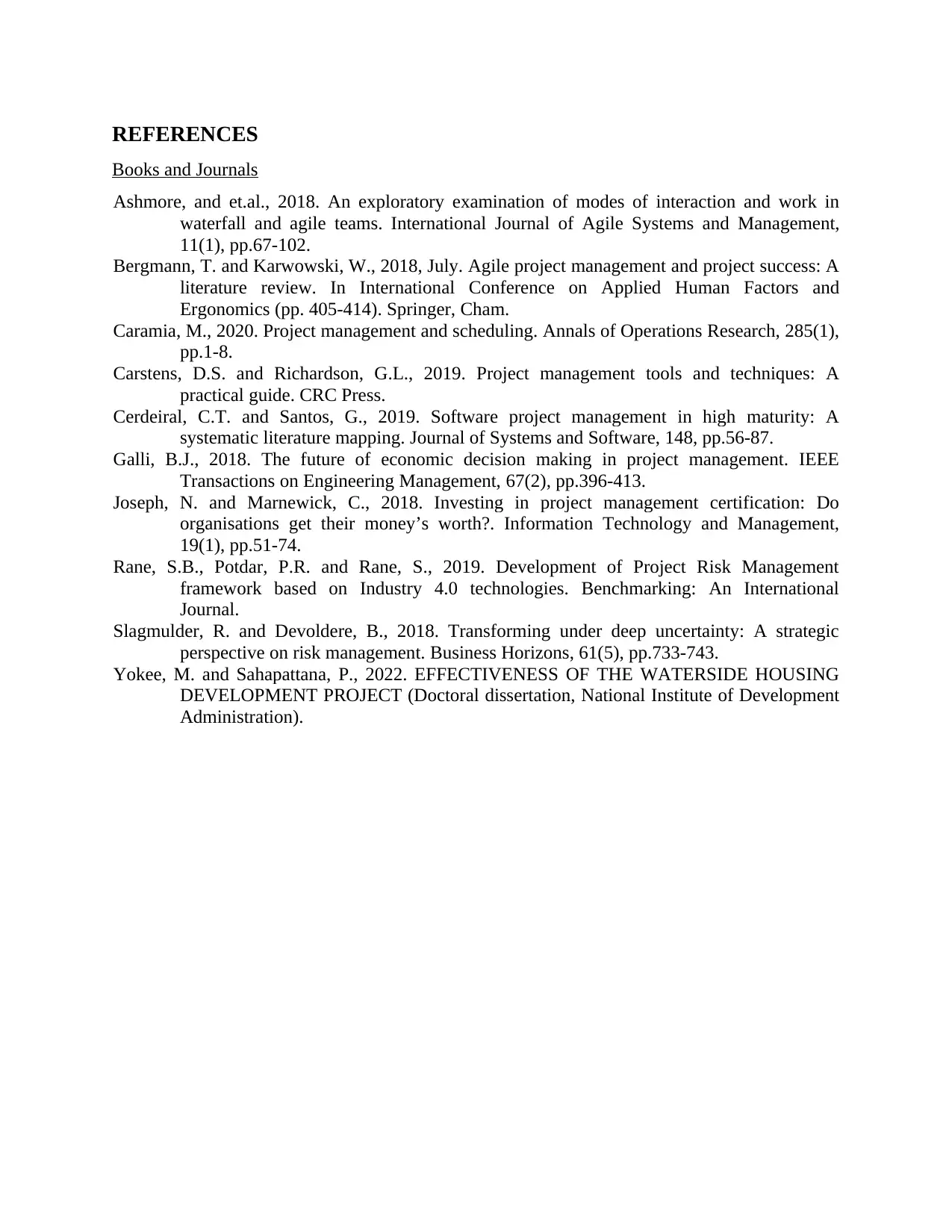
REFERENCES
Books and Journals
Ashmore, and et.al., 2018. An exploratory examination of modes of interaction and work in
waterfall and agile teams. International Journal of Agile Systems and Management,
11(1), pp.67-102.
Bergmann, T. and Karwowski, W., 2018, July. Agile project management and project success: A
literature review. In International Conference on Applied Human Factors and
Ergonomics (pp. 405-414). Springer, Cham.
Caramia, M., 2020. Project management and scheduling. Annals of Operations Research, 285(1),
pp.1-8.
Carstens, D.S. and Richardson, G.L., 2019. Project management tools and techniques: A
practical guide. CRC Press.
Cerdeiral, C.T. and Santos, G., 2019. Software project management in high maturity: A
systematic literature mapping. Journal of Systems and Software, 148, pp.56-87.
Galli, B.J., 2018. The future of economic decision making in project management. IEEE
Transactions on Engineering Management, 67(2), pp.396-413.
Joseph, N. and Marnewick, C., 2018. Investing in project management certification: Do
organisations get their money’s worth?. Information Technology and Management,
19(1), pp.51-74.
Rane, S.B., Potdar, P.R. and Rane, S., 2019. Development of Project Risk Management
framework based on Industry 4.0 technologies. Benchmarking: An International
Journal.
Slagmulder, R. and Devoldere, B., 2018. Transforming under deep uncertainty: A strategic
perspective on risk management. Business Horizons, 61(5), pp.733-743.
Yokee, M. and Sahapattana, P., 2022. EFFECTIVENESS OF THE WATERSIDE HOUSING
DEVELOPMENT PROJECT (Doctoral dissertation, National Institute of Development
Administration).
Books and Journals
Ashmore, and et.al., 2018. An exploratory examination of modes of interaction and work in
waterfall and agile teams. International Journal of Agile Systems and Management,
11(1), pp.67-102.
Bergmann, T. and Karwowski, W., 2018, July. Agile project management and project success: A
literature review. In International Conference on Applied Human Factors and
Ergonomics (pp. 405-414). Springer, Cham.
Caramia, M., 2020. Project management and scheduling. Annals of Operations Research, 285(1),
pp.1-8.
Carstens, D.S. and Richardson, G.L., 2019. Project management tools and techniques: A
practical guide. CRC Press.
Cerdeiral, C.T. and Santos, G., 2019. Software project management in high maturity: A
systematic literature mapping. Journal of Systems and Software, 148, pp.56-87.
Galli, B.J., 2018. The future of economic decision making in project management. IEEE
Transactions on Engineering Management, 67(2), pp.396-413.
Joseph, N. and Marnewick, C., 2018. Investing in project management certification: Do
organisations get their money’s worth?. Information Technology and Management,
19(1), pp.51-74.
Rane, S.B., Potdar, P.R. and Rane, S., 2019. Development of Project Risk Management
framework based on Industry 4.0 technologies. Benchmarking: An International
Journal.
Slagmulder, R. and Devoldere, B., 2018. Transforming under deep uncertainty: A strategic
perspective on risk management. Business Horizons, 61(5), pp.733-743.
Yokee, M. and Sahapattana, P., 2022. EFFECTIVENESS OF THE WATERSIDE HOUSING
DEVELOPMENT PROJECT (Doctoral dissertation, National Institute of Development
Administration).
1 out of 11
Related Documents
Your All-in-One AI-Powered Toolkit for Academic Success.
+13062052269
info@desklib.com
Available 24*7 on WhatsApp / Email
![[object Object]](/_next/static/media/star-bottom.7253800d.svg)
Unlock your academic potential
Copyright © 2020–2025 A2Z Services. All Rights Reserved. Developed and managed by ZUCOL.

